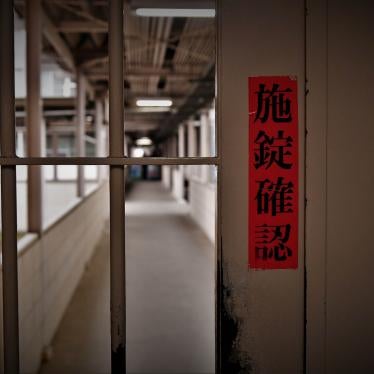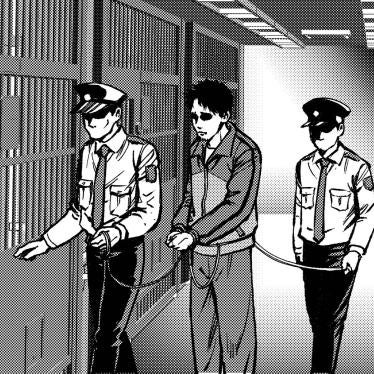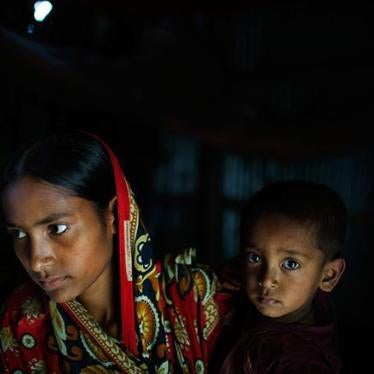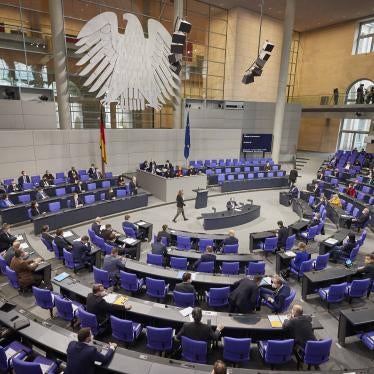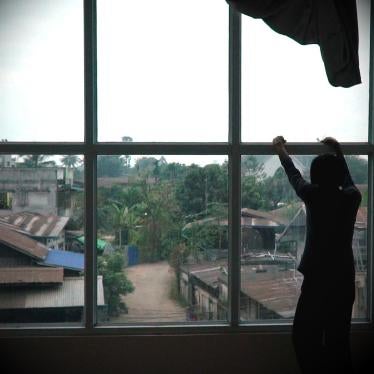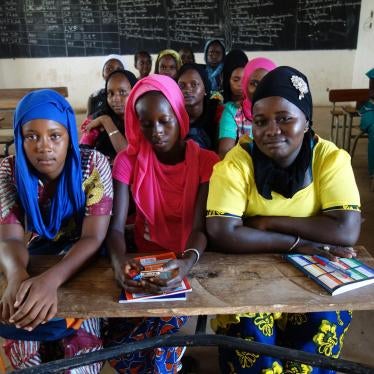(ドネツク)ウクライナ政府軍と親政府民兵組織が発射したと見られる無誘導ロケット砲「グラート」により、少なくとも民間人16人が死亡、多数が負傷した。攻撃はドネツクとその近郊の反政府勢力支配地域で、2014年7月12日から21日に少なくとも4回行われたと、ヒューマン・ライツ・ウォッチは本日述べた。
人口集中地域での無差別なロケット砲の使用は、戦時国際法(戦争法)違反であり、戦争犯罪の可能性がある。
グラートは正確に標的を狙うことのできない無誘導ロケット弾だ。多連装ロケット砲での一斉射撃により、広い地域を飽和攻撃するために用いられることが多い。ヒューマン・ライツ・ウォッチはウクライナ東部での紛争の全当事者、とくにウクライナ政府軍に対し、民間人死傷の可能性にかんがみ、グラート・ロケット砲の人口集中地域内部またはその周囲で使用するのを止めるよう求める。反政府勢力は、特に人口が集中する地域への兵力と兵器の展開を止め、支配地域内の民間人が被るリスクを最小限にすべきだ。
「グラート・ロケット砲の不正確さは悪い意味でよく知られている。人口集中地域に用いるべきではない」と、ヒューマン・ライツ・ウォッチの緊急対応部門上級調査員ウレ・ソルバンは述べた。「反政府勢力とウクライナ政府軍が、民間人の犠牲を少なくする気が本当にあるのなら、双方共に人口集中地域でこうした兵器を使うことを止めるべきだ。」
ウクライナ反政府勢力は4月、ウクライナ東部にある人口100万ほどの街ドネツクを支配下に置いたと発表した。安全上の理由から、ヒューマン・ライツ・ウォッチは、反政府勢力とその施設のグラート・ロケット砲による被害状況を直接検証することができない。
最近、ウクライナ政府と反政府勢力の双方がグラート・ロケット砲を使用している。ウクライナ政府当局者とウクライナ国民防衛軍広報部は、ドネツクでのグラート・ロケット砲使用を否定している。だがヒューマン・ライツ・ウォッチの現地調査は、7月12日から21日にかけて攻撃を行ったのがウクライナ政府軍であることを強く示唆するものだ。
この4回の攻撃は、反政府勢力と政府軍が対峙する前線付近で行われた。地上と建物の弾孔をヒューマン・ライツ・ウォッチが調査したところ、砲弾ではなくロケット弾の攻撃の特徴が認められた。4件すべてについて、弾孔の角度と形状、ならびに弾孔が建物の前線に面した側についている事実は、ウクライナ政府軍か親政府武装組織がいる方角から、ロケット弾が発射されたことを強く示唆する。前線近くで攻撃が行われたことは、反政府勢力による攻撃の可能性を弱めるものであり、場合によっては完全に否定するものだ。うち2回の攻撃で、ロケット弾が反政府勢力の基地と検問所とその周辺に着弾し、同時に住宅地にも着弾した。このことは攻撃が政府軍によるものであることを示唆する。
7月21日の攻撃では、ドネツク駅近くの住宅地にロケット弾が着弾し、民間人3人が死亡した。戦闘中のため、ヒューマン・ライツ・ウォッチは犠牲者がさらに増えたかを確認することは難しい。しかし発射音でグラート・ロケット砲とわかるものが、一日中ずっと聞こえていた。
7月19日、ドネツク市西部クイビシェフスキー区の住宅地にロケット弾5発が着弾。民間人が少なくとも4人負傷した。
ヒューマン・ライツ・ウォッチは、ドネツク市西端のペトロフスキー区の住宅地に7月12日、多数のロケット弾が着弾した事例を記録した。
同じく12日には、ドネツク市ペトロフスキー区そばのマリンカ村の住宅地に多数のロケット弾が着弾。民間人が少なくとも6人死亡した。
ヒューマン・ライツ・ウォッチは、発射されたロケット弾が、最大40本の発射筒を持つ多連装ロケット砲から発射された、無誘導122mm地対地グラート・ロケットだと特定した。その射程は通常1.5~20km。弾頭の大きさは1.9~3.3m、重さは45~75kgだ。
グラート・ロケット砲では各種の弾頭を用いることができる。最も多いのは破砕性弾頭。6.4kgの高性能爆薬を搭載し、3,150個に分散するように設計されている。半径28mについて殺傷能力を有する。最大射程距離は約20kmだが、基本的な破砕性弾頭(M-21-OF)を持った代表的なロケット弾(9M22U)の正確さは、336m×160mの枠内にすぎない。つまり、このロケット弾は約54,000平方メートルの範囲のどこかに着弾するのだ。
ウクライナ東部の戦闘には戦争法が適用される。紛争の全当事者がその対象だ。グラート・ロケット砲には、攻撃が許される軍事目標と、攻撃対象とはできない民間人、および軍事目的に使用されていない家屋や学校などの民間施設を識別して標的を絞るだけの精度がない。 正確に言えば、グラート・ロケット弾を人口集中地域に使用することは、無差別攻撃を禁じた戦争法に違反する行為だ。さらに言えば、正当な軍事目標を狙わない攻撃は、法に反する無差別的なものである。
ヒューマン・ライツ・ウォッチは、反政府勢力が、特に人口が集中する地域での部隊展開を避けるための最大限の予防措置を行っておらず、戦争法に反して民間人を危険にさらしていると指摘した。たとえば、分離独立派の部隊が町の中心部に基地を移したときに、グラート・ロケットが基地と付近の住宅地に撃ち込まれている。当事者の一方が戦争法に違反したことを理由に、もう片方が法に背くことは許されない。
犯罪の自覚があり、つまり故意あるいは重過失により、戦争法への重大な違反行為をなす個人は、戦争犯罪の責任を問われる。
「ウクライナ当局は志願兵も含めた全部隊に対し、人口集中地域内や付近でのグラート・ロケット弾の使用停止を命じるべきだ。また反政府勢力は特に人口集中地域での部隊展開を避けるべきだ」と、前出のソルバンは述べた。「両軍の指揮官は、自分たちの行動の法的責任を問われる日が来ることを自覚すべきだ。」
ヒューマン・ライツ・ウォッチは、ウクライナを支援する国際社会のアクターに対し、同国政府に人口集中地域でのグラート・ロケット使用の全面禁止を行うなど、国際人道法を厳守するよう求めることを要請した。
攻撃の詳細は以下をご覧ください:
Attacks Near the Train Station, July 21
On July 21, Ukrainian government forces stationed on the northwest edge of Donetsk began a military offensive against insurgent forces in the area around and north of the train station. Because of contradictory statements by Ukrainian authorities, it was not immediately clear whether the offensive was conducted by government forces or pro-Kiev volunteer forces operating on their own.
Media reports quoted a spokesman for Ukraine’s military stating that the fighting around the train station was “a planned offensive ... to push rebels away from the airport,” but that “[a]viation and artillery are not aiming at civilian residences. Their only aim is to block the terrorists and fighters.” In a separate media report, Andriy Lysenko, a spokesman for Ukraine’s National Security Council, denied that government forces were involved in any fighting, but claimed that a small self-organized group of pro-Kiev forces were fighting insurgents.
Information collected by Human Rights Watch indicates that the Grad rockets killed at least three civilians during the attack.
Local residents told Human Rights Watch that several rockets had struck their neighborhood, just south of the train station, at about 10:30 a.m. They said one of the rockets struck the courtyard of an apartment complex, killing one woman and wounding a man. The woman did not live in the apartment complex so the neighbors did not know her name.
A Human Rights Watch visit to the site found an impact crater with blood next to it in the middle of the courtyard. There was also blood on the steps leading up to one of the nearby buildings. Neighbors said shrapnel from the same rocket had injured a man there and that he then tried to drag himself up the steps and into the building.
While the area is generally under insurgent control, as is most of Donetsk, local residents told Human Rights Watch that no insurgent forces or weapons had been in the area at the time of the attack.
Foreign journalists told Human Rights Watch that a second rocket killed two men near a school about 100 meters away from the rocket that killed the woman. A security expert working with the New York Times provided Human Rights Watch with the GPS coordinates of the strike that killed the two men and another strike in the immediate vicinity.
The security expert also provided Human Rights Watch with GPS coordinates for three impact sites, also in a residential area, located to the northeast of the train station. There was no information about casualties from that area.
Human Rights Watch heard what appeared to be salvos of Grad rockets being launched from multi-barrel launchers from the north of the city throughout the day, but ongoing fighting made it difficult to establish whether there were additional civilian casualties.
Attack on Kuibyshivskyi district, July 19
Human Rights Watch documented five impact sites in Pervaya Ploshchad, a residential area of mostly three- to five-story buildings on the western edge of Donetsk, caused by a rocket attack at about 4 p.m. on July 19.
One of the rockets struck a five-story residential building at 6 Tumanyana Street. Valentina Fedorovna, 77, who lives on the ground floor, told Human Rights Watch:
I was just about to turn on the TV when I heard a loud whistling noise and a big bang. Then I don’t remember anything more until somebody shouted “Is there anybody alive in here?” Then a young man came and pulled me out. I was completely in shock.
Another resident, who was injured by a piece of shrapnel that went through her arm and a smaller one lodged in her chest, told Human Rights Watch:
All of a sudden I felt an explosion that pushed back so I hit my head. I didn’t even notice that I was wounded. All the windows shattered. People were screaming.
A Human Rights Watch examination of the site found that the rocket had entered through the second floor of the building, continued through the kitchen and bathroom of Valentina Fedorovna’s apartment on the ground floor, and went farther down to the basement.” If the rocket had hit two meters to the left it would have gone through the living room where I was sitting instead of the kitchen,” Valentina Fedorovna said.
Another rocket, which hit the courtyard about 20 meters from Valentina Federovna’s building, wounded four people, who were taken to the hospital. Neighbors said one woman was seriously injured by a piece of shrapnel that lodged in her chest.
A third rocket struck the playground of School 71; a fourth hit the road outside the local church, shattering most of the windows; and a fifth hit a single-story house that was empty at the time.
Both the flight direction of the rockets and circumstances of the attack indicate that Ukrainian government forces were responsible. The rocket striking 6 Tumanyana Street hit its western façade. The crater in the soft ground in the school playground also showed that the rockets came from a western direction. At the time of the attack, the front line between insurgent and Ukrainian government forces was several kilometers farther west, according to local residents.
Insurgent forces manning a checkpoint about three kilometers west of the Pervaya Ploshchad area told Human Rights Watch that Grad rockets had also hit their checkpoint and the area between the checkpoint and the residential area in the same attack. Human Rights Watch observed craters, marks on the asphalt, and remnants of Grad rockets near the checkpoint and between the checkpoint and the residential area that were consistent with this account.
Attack on Petrovskyi district, July 12
At about 4 p.m. on July 12, multiple Grad rockets hit a residential area in Petrovskyi district in the western part of Donetsk. The area that was hit is several kilometers north of a road that demarcates the front line between insurgent and Ukrainian government forces.
Human Rights Watch examined 19 impact craters in an area about 600 meters wide. Local residents also showed Human Rights Watch remnants from Grad rockets that they said had hit their gardens or houses.
In one case, a rocket struck the house and garage at 2 Chugaeva Street, killing an entire family of two adults and two children.
Liudmila, 62, was at home in Chugaeva Street when the attack happened. She told Human Rights Watch:
I was in my room when I first heard a whistling sound. The walls and windows started to shake and then there were many loud bangs. My son was in the kitchen. He came running when the attack started, probably trying to save me, but a shrapnel hit him in the leg. What’s here that they wanted to attack? There is no factory here, no fighters, just poor houses.
Liudmila’s car was destroyed in the attack and Human Rights Watch observed significant damage to her house. Her son was recovering.
An officer on duty in the local police station showed Human Rights Watch the logbook from July 12 and provided Human Rights Watch with addresses where people had died during the attack. The police had registered seven deaths, including the four people mentioned above.
Craters and marks on buildings showed that the rockets had been launched from a location to the southeast. The likely launch area is located south of the southern-most checkpoint manned by insurgent forces.
Several of the impact craters indicated that the rockets had come from a southern direction. Local residents said that there had been no insurgent forces or weapons in the area before the attack.
Attack on Maryinka, July 12
At about 10 p.m. on July 12, multiple Grad rockets struck an area in the southeastern part of the village of Maryinka, which consists of fields, an industrial zone, and a residential area, clustered around a milk factory.
Maryinka has about 10,000 inhabitants and is just outside the western edge of Donetsk, adjacent to the Petrovskyi district. It consists mainly of three- to five-story buildings.
A 25-year-old taxi driver told Human Rights Watch:
I was at home when the attack started. I ran to the basement immediately, but the attack was over in about 40 seconds. There was no warning. Nothing had happened here before. I only came out from the basement when the [insurgents] came to evacuate us. Everything was burning and there was debris everywhere. I never thought that something like this could happen here.
The local department for housing and utilities, which documented the effects of the strike, provided Human Rights Watch with the names of six people who died in that attack. All of those killed were between the ages of 45 and 60. Fifteen people were taken to the hospital, a department employee said, most with light injuries such as concussions.
Human Rights Watch documented multiple Grad rocket impacts in the residential area. Several buildings had been hit directly, and most buildings in the area had broken windows. According to the housing and utilities department, at least 12 apartment buildings had direct rocket hits. Human Rights Watch discovered remnants of Grad rockets in multiple locations in the area that was hit, including inside destroyed apartments.
At the time of the attack, insurgent forces manned a checkpoint about 800 meters southwest of the edge of the village, and an unknown number of insurgent forces were deployed on the opposite side of the road, between the checkpoint and the residential area that was hit. The base commander said that both the checkpoint and the base were struck at the same time as the residential area and that 22 rockets landed on the territory of his base. There were additional Grad attacks against the same area in at least the two following days, residents and the commander said, but most civilians evacuated immediately after the initial attack. Following the attacks, the insurgent base relocated closer to the center of Maryinka, the commander said.
Ukrainian government forces appear responsible for the attacks. All the rockets that had struck buildings hit walls facing southwest, indicating that the rockets came from there. Insurgent force personnel told Human Rights Watch that none of their troops were located farther southwest beyond the checkpoint 800 meters from the residential part of Maryinka, which, if true, would not have made it possible for them to have carried out the attack. A journalist who travelled to some of the villages southeast of Maryinka two days after the attack told Human Rights Watch that he saw no insurgent forces in that area at that time.
The journalist told Human Rights Watch that pro-Kiev forces in non-standard uniforms in Novomikhaylivka, a village southwest of Maryinka, had boasted to him the following day that they had a Grad rocket system and that they were firing on insurgent forces. The soldiers told the journalist that their aiming was accurate because they had scouts that helped them direct the fire.
A resident of Maryinka who fled to another village after the attack told Human Rights Watch that he saw Grad rockets being launched twice from a village farther southwest, which was under the control of Ukrainian forces on July 13.
